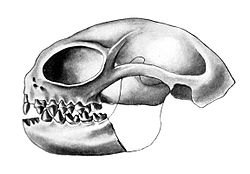Omomyid
| Omomyidae Temporal range: 56–34 Ma Late Paleocene – Oligocene |
|
|---|---|
 |
|
| The skull of Anaptomorphus | |
| Scientific classification | |
| Kingdom: | Animalia |
| Phylum: | Chordata |
| Class: | Mammalia |
| Order: | Primates |
| Suborder: | Haplorrhini |
| Infraorder: | Tarsiiformes |
| Superfamily: | Omomyoidea |
| Family: | Omomyidae |
| Subfamilies | |
Omomyidae is a family of early primates that radiated during the Eocene epoch between about 55 to 34 million years ago (mya). Fossil omomyids are found in North America, Europe, Asia, and possibly Africa, making it one of two groups of Eocene primates with a geographic distribution spanning holarctic continents, the other being the adapids (family Adapidae). Early representatives of the Omomyidae and Adapidae appear suddenly at the beginning of the Eocene (59 mya) in North America, Europe, and Asia, and are the earliest known crown primates.
Features that characterize many omomyids include large orbits (eye sockets), shortened rostra and dental arcades, loss of anterior premolars, cheek teeth adapted for insectivorous or diets, and relatively small body mass (i.e., less than 500 g). However, by the late middle Eocene (about 40 mya), some North American omomyids (e.g., Macrotarsius) evolved body masses in excess of 1 kg and frugivorous or folivorous diets. Large orbits in genera such as Tetonius, Shoshonius, Necrolemur, and Microchoerus indicate that these taxa were probably nocturnal. At least one omomyid genus from the late Eocene of Texas (Rooneyia) had small orbits and was probably diurnal.
Like primates alive today, omomyids had grasping hands and feet with digits tipped by nails instead of claws. Features of their skeletons strongly indicate that omomyids lived in trees. In at least one genus (Necrolemur), the lower leg bones, the tibia and fibula, were fused as in modern tarsiers. This feature may indicate that Necrolemur leaped frequently. Most other omomyid genera (e.g., Omomys) lack specializations for leaping, and their skeletons are more like those of living dwarf and mouse lemurs.
...
Wikipedia
